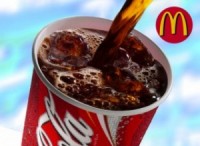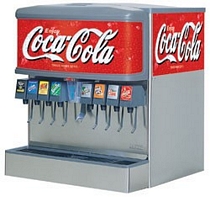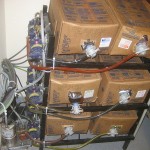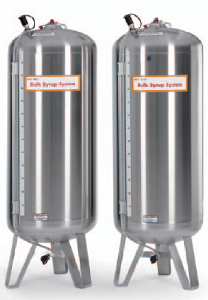Secret to why McDonald’s Coke Tastes Best
 Everyone who sells Coca-Cola fountain drinks uses the same syrup and fountain machines but McDonald’s tastes better. Learn McDonald’s impossible innovation.
Everyone who sells Coca-Cola fountain drinks uses the same syrup and fountain machines but McDonald’s tastes better. Learn McDonald’s impossible innovation.
 If you’ve ever bought a Coca-Cola from a gas station soda fountain you’ve probably noticed it doesn’t taste the same as Coca-Cola from McDonald’s. You might have noticed that a Coke from other restaurants also don’t taste the same. If you look at how Coca-Cola controls every aspect from the syrup to the fountain machine you probably wonder why it doesn’t taste exactly the same everywhere.
If you’ve ever bought a Coca-Cola from a gas station soda fountain you’ve probably noticed it doesn’t taste the same as Coca-Cola from McDonald’s. You might have noticed that a Coke from other restaurants also don’t taste the same. If you look at how Coca-Cola controls every aspect from the syrup to the fountain machine you probably wonder why it doesn’t taste exactly the same everywhere.
If you are like most people, you agree Coca-Cola from McDonald’s tastes better than anywhere else. It’s hard to describe the exact way it tastes better but it certainly does. Moreover, it consistently tastes better at every McDonald’s.
What is McDonald’s the secret?
One of steps of Predictive Innovation® is to list the objects for a scenario. In the scenario of making Coca-Cola fountain drinks the objects are:
- water
- syrup
- CO2
- ratio of ingredients
- mix of ingredients
- temperature
Objects
Of all those objects, McDonald’s can only control two of them. The rest of the objects are controlled by Coca-Cola or the customers. The two things McDonald’s can control are their water and the freshness of the syrup. CO2 is a standard gas that makes the drink fizzy. The ratio of ingredients and the mix of ingredients is controlled by the fountain machine and that is set by Coca-Cola. Customers can change the temperature by adding ice. Water and freshness of syrup are the secret of McDonald’s fountain drink innovation.
Water
Water is 85% of a fountain drink. If the water is bad you will taste it. Like everything else McDonald’s does, they meticulously control their water. Each restaurant has a reverse osmosis filter providing the best water available. This not only makes the Coca-Cola taste better it also makes their coffee taste better. The water you get at McDonald’s is the cleanest anywhere and that is the #1 reason their fountain drinks taste the best.
Syrup
 Most Coke retailers get their syrup in a bag box. These bag boxes are small and allow a retailer to provide Coke with a minimal investment.
Most Coke retailers get their syrup in a bag box. These bag boxes are small and allow a retailer to provide Coke with a minimal investment.
 McDonald’s sells a lot of Coke. They sell so much coke that they don’t need to buy the syrup in the small bag box. McDonald’s restaurants can get syrup delivered from a tanker truck and store it in a stainless steel cylinder. Because they sell a lot it doesn’t sit around as long. So the Coke syrup at McDonald’s is fresher than their competitors. Fresher syrup makes better tasting fountain drinks.
McDonald’s sells a lot of Coke. They sell so much coke that they don’t need to buy the syrup in the small bag box. McDonald’s restaurants can get syrup delivered from a tanker truck and store it in a stainless steel cylinder. Because they sell a lot it doesn’t sit around as long. So the Coke syrup at McDonald’s is fresher than their competitors. Fresher syrup makes better tasting fountain drinks.
McDonald’s also controls freshness by cleaning everything daily. Letting syrup sit in hoses and machines allows it to chemically degrade and for bacteria to grow. Keeping everything clean also keeps it fresh and tasting good.
So even though all their competitors have the same basic ingredients that are required to be put together the exact same way, McDonald’s found a way to innovate and provide a better product.
Action Items
- What are the objects in your product or process?
- How can you change an object to innovate?
Disruptive Innovation, Not Here
Innovation is the big buzz word these days. Christensen’s “Disruptive Innovation” books popularized systematic innovation. Growing up in the middle of the personal computer revolution I’ve experienced first hand repeated massively disruptive innovation.Perhaps because so much innovation has occurred in the high technology industry, people associate innovation with technology. My own experience has shown me that the mental technologies, the thoughts and ideas, concepts and procedures, values and perceptions have the most potential for disruptive innovation.
Let’s look at an example. My first paid programming job was creating software to apply statistical quality control. Our software was the first time a US automotive manufacturer used statistical process control. Our software was good; it saved work and provided answers that weren’t possible doing things by hand. But they weren’t doing it by hand. They weren’t doing it at all. The big impact wasn’t the technology being used; it was that they were using it. This was the first time the US auto industry consistently measured quality and applied the results toward improving.
Today it might seem obvious to measure quality. We constantly hear about quality surveys, crash tests and measurements of all kinds and all sorts. But in the early 1980’s that was basically unheard of. Only lab coat scientists took samples and used statistical models.
Affordable computers and the software I and others created made it possible to measure like never before but the biggest step was in seeing the value and doing it. As obvious as it seems today the US auto industry simply saw no value in measuring quality. But in the 1980’s the Japanese were starting to take over and it was all because of statistical process control.
The statistical process control movement was started by Deming. Oddly enough he had gone to the US Auto Makers first. He showed them this great new technique.
Deming showed that if you measure every part you make you can learn how your process works. Once you understand your process you can predict quality problems before they happen, thus avoiding the problem and produce higher quality more reliably and efficiently. For example if you’re drilling holes your drill bit wears down. After a while it stops making the holes to the proper size and shape. But if you know how long it takes for the bit to wear out you can replace it before it starts making bad parts. So you always make good parts. There is a lot more to it than that but that is the basic concept.
When the US auto makers heard Deming’s technique they rejected it outright. They said, “Measuring everything will cost too much. Your idea sounds great but we don’t need it. We don”t have a problem with quality. We could slap chrome on a turd and customers would buy it.” The truth was they had huge problems with quality but they weren’t yet feeling the effects. Maybe in the 1950’s and 1960’s a chromed turd would sell but that would change. A huge disruptive innovation was about to take place, and they chose to ignore it.
See after World War II Japan was destroyed. They were starting from scratch. By the 1960’s Japan’s industry was functioning again but they were thought of as the low cost low quality manufacturer of “cheap” things. Today in 2006 we often apply that label to Chinese products, remember that. China is now considered the same way that we once considered Japan. So how did Japan come from being the maker of cheap junk to being the recognized leader in hi-tech and hi-quality? It was through an attitude.
After being laughed at in the US, Deming went to Japan. The Japanese realized they needed something to help them, so they were open to change. That is the first most important element of innovation. All innovation starts and ends with people. Technology is a tool; innovation is the tool in action.
The Japanese took Deming’s statistical process control and turned it into a lifestyle. So in the 1980’s when I was implementing the first SPC system at a US auto plant, the Japanese had grown past it. They weren’t just 1 step ahead they were now 2 steps ahead and starting to capture the automotive market and building new markets they owned.
The Japanese accepted that they could do better. They used this new technique then they applied technology to maximize the effectiveness.
I’ve only scratched the surface of innovation. I’ll cover more about this in future articles. I’ll explore this more when I cover the following: Google, Copyrights, Democracy and Terrorism.
Action Items:
- Make a list of tasks you regularly perform.
- List 5 ways you can improve each of those tasks. Ex.: faster, cheaper, easier, more options, for more people.
- Estimate a value of having those improvements.
- Estimate the potential loss if your competitor made that improvement and you didn’t.
Request a FREE copy of What Makes an Innovation System Complete.



 Predictive Innovation Training
Predictive Innovation Training Predictive Innovation: Core Skills Book
Predictive Innovation: Core Skills Book RoundSquareTriangle.com
RoundSquareTriangle.com